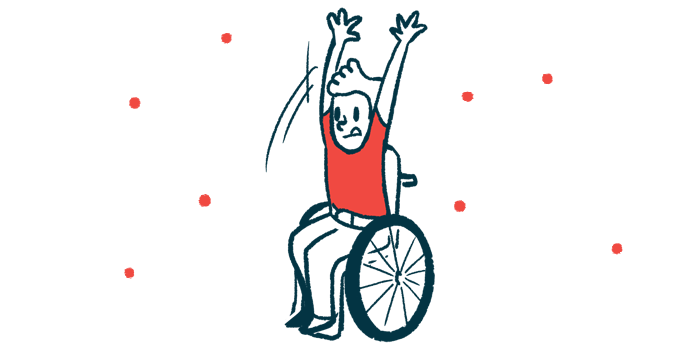Scoliosis Progression Detailed in Untreated SMA Type 2 Children
Age, limited motor abilities associated with more severe spinal curvature in study
Written by |

Severe scoliosis — an abnormal curvature of the spine — was significantly associated with older age and limited motor abilities in children with spinal muscular atrophy (SMA) type 2 who had not received disease-modifying therapies, a study showed.
These findings establish characteristics of untreated scoliosis progression on SMA type 2 patients to which future studies about the effects of such therapies on scoliosis can be compared, the researchers said.
The study, “Long term follow-up of scoliosis progression in type II SMA patients,” was published in Neuromuscular Disorders.
A feature of SMA is progressive muscle weakness and wasting that mainly affects motor function, but can lead also to problems with breathing, swallowing, and speaking. Different types of SMA are classified based on the age of onset and the highest achieved motor milestone.
Although children with SMA type 2 can sit independently, they can’t walk without assistance and, as a result of weakened back muscles, they eventually develop scoliosis, an abnormal “S” curvature of the spine. Scoliosis can affect patients’ mobility and cause breathing difficulties.
The approval of three disease-modifying therapies for SMA in the past decade — Spinraza (nusinersen), Zolgensma (onasemnogene abeparvovec), and Evrysdi (risdiplam) — have led to significant improvements in motor and lung function for patients.
Their effects on scoliosis have yet to be systematically reported, however, partly due to a lack of information on scoliosis progression in untreated patients. As a result, demonstrating differences between treated and untreated patients is challenging.
To establish a history of scoliosis progression, researchers in Italy retrospectively analyzed the medical records of 84 children (mean age, 5.81) with SMA type 2 who had scoliosis but hadn’t received approved disease-modifying treatments.
Severity and the absence of treatment
Patients had at least one recorded Cobb’s angle, a measurement of scoliosis degree obtained through an X-ray scan in a sitting position. Cobb’s angles between 10–30 degrees indicate mild scoliosis, 30–45 degrees indicate moderate scoliosis, and more than 45 degrees are considered severe scoliosis.
Results showed the mean Cobb’s angle for all 84 children, based on 287 angle measurements, was 46 degrees, indicating severe scoliosis.
“There was a progressive increase of scoliosis angle with increasing age,” the team wrote.
The mean Cobb’s angle was 24 degrees in those younger than 5, 37 degrees in children 5–7, 62 degrees in those 8–12, and 82 degrees in children older than 13.
The difference in Cobb’s angles between age groups was statistically significant and children younger than 5 and those between 5–7 had a significantly lower mean scoliosis angle than those 8–12 years and 13 and older.
The team next divided the children by motor abilities based on the Hammersmith Functional Motor Scale Expanded (HFMSE) where lower scores reflect poorer motor function.
There was a progressive increase in Cobb’s angle with decreasing HFMSE scores across all levels of disease severity. Children scoring less than 10 on HFMSE had a 55-degree mean angle, while those scoring between 11–22 had a 43-degree mean angle. Children with HFMSE scores above 22 had a 22-degree mean angle.
There was a progressive increase of scoliosis angle with increasing age.
“The difference in the mean scoliosis angle between HFMSE categories was significant,” the researchers wrote.
Those scoring less than 10 on the HFMSE had a significantly higher mean Cobb’s angle than patients achieving scores between 11–22. The angle was significantly lower in those who scored above 22 than in the other two groups.
Significant differences were also found between those with different copy numbers of the SMN2 gene, whose higher copy numbers are associated with milder SMA severity, but not across sexes.
A look at the annual rate of progression
To determine the annual rate of scoliosis progression, the team focused on the 54 children who had at least two Cobb’s angle measurements with a six-month interval. Follow-up was interrupted in 19 cases due to scoliosis surgery to correct spinal curvature. Based on the available data, the scoliosis angle increased at a rate of 5.63 degrees a year.
“Age, functional status and scoliosis angle registered at [the study’s start] were found to have a significant effect on the scoliosis angle progression,” the researchers wrote.
Forty-five of the 54 patients had at least one pair of angle measurements separated by one year.
Over one year, the mean Cobb’s angle increased by 9.3 degrees across this subgroup — 7.6 degrees in those younger than 5, 9.9 degrees in those between 5–7, 11 degrees in those between 8–12, and 4.8 degrees for older than 13.
“Our results confirm the progression of scoliosis in type [2] SMA also providing details of the progression in relation to different variables,” the researchers wrote, noting it was not surprising to see that age had a strong impact on scoliosis angles.
“Our data may be of help in the interpretation of the results to establish possible differences in the trajectories of progression between treated and untreated type [2] individuals,” they said.







